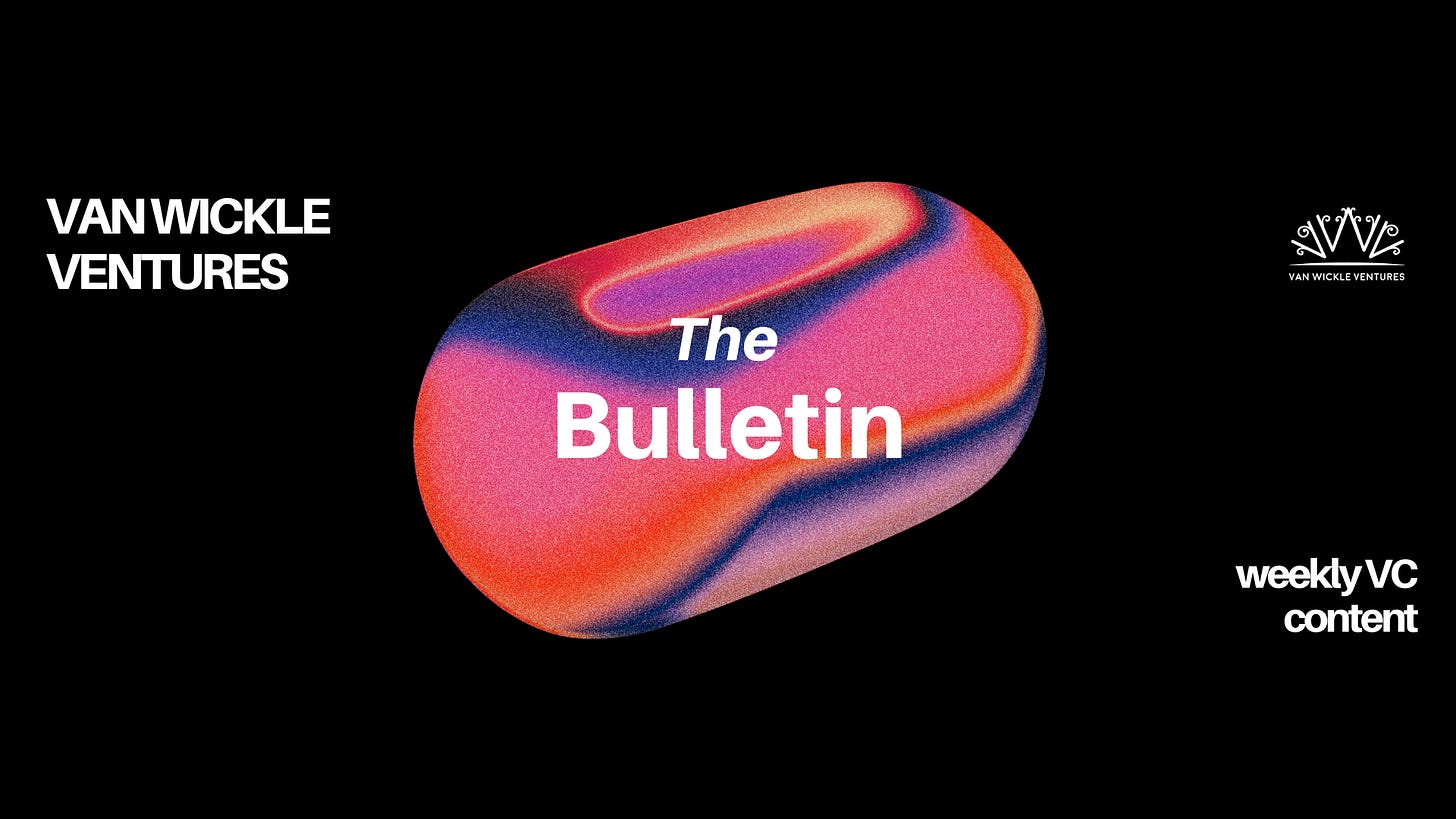🖼️ The Bulletin #72: ChatGPT's New Image Generation, the TLDR on Vibe Coding, CoreWeave's $23B IPO, and a Startup Spy Scandal
In this week's bulletin - ChatGPT's new image capabilities 🎞️, a dive into vibe coding 👾, unpacking CoreWeave's $23B IPO 📉, and a startup spying saga 🕵️♂️
Hey there! Welcome back to the VWV Bulletin! We hope you had a fantastic Spring Break. This week, we’ve got an AI filled bulletin for you! 🔥
💡For this semester, keep up with our content if you’re interested in:
Demystifying & breaking into VC
Finding opportunities in the start-up world
Keeping up with VC investment news at Brown & beyond (pro tip: this is essential to breaking in and finding opportunities)
Enjoy the Bulletin! 😁
⚡️ Images in ChatGPT Takes the Internet by Storm
As you've probably seen through your social media feeds being swarmed with Studio Ghibli-style images, last week, OpenAI rolled out a new image generation model in ChatGPT.🎉 This new model is far more capable than the previous ones. It excels at rendering text, precisely following prompts, using chat context and leveraging GPT-4o's existing knowledge base, aspects which ChatGPT previously struggled with to the frustrations of users.💢
How Does it Work? 🔢
Previously, image generation in ChatGPT used OpenAI's separate DALL-E series of models. These models would start out with nothing but noise and slowly refine the pixels to create the desired image, in a process known as stable diffusion. In contrast, Images in ChatGPT is auto-regressive. Like when using ChatGPT for text, it generates an output token by token based off the most probably next token as determined by the context, i.e. the prompt and the current text in the reply. Instead of text however, the tokens are pixels.👾 This is what allows the new model to precisely follow prompts, leverage context and use 4o's existing knowledge so well. An overview of auto-regressive image models is outlined in the infographic below, created by ChatGPT.‼️
Suffering from Success 😬
People's recreation of images of themselves or their pets in a Studio Ghibli art style thanks to Images in ChatGPT helped the launch quickly go viral.📈 Demand was so explosive that OpenAI had to rollback access and limit usage for free tier users.
This mass "Ghiblification" has also drawn increased criticism regarding the issue of copyright and further complicated the legal questions regarding AI-generated art.👨⚖️ OpenAI says that it does not allow the recreation of the style of specific artists, but permits broader studio styles. However, given that Studio Ghibli's style was largely the brain-child of Hayao Miyazaki – who called AI-generated animation "an insult to life itself" back in 2016 – this distinction is complicated… 🤔
Strategic Moves ♟️
The stunning examples shown go to illustrate the key point about this new product development – image generation that is actually useful. It follows a broader trend with a lot of AI products, which start off as cool but borderline tech-demos, like the early GPT and DALL-E models, into incredibly useful and timesaving services, like Deep Research, Operator – and now Images in ChatGPT. These features act as genuine substitutes for work consumers and companies already pay for, giving a serious incentive for purchase.💰 Such developments will continue to be necessary as skyrocketing costs for the company lead internal company projections to not expect profitability until 2029.😯
😎 What is Vibe Coding?
Recently, a tweet by Andrej Karpathy, co-founder of OpenAI and former head of AI at Tesla, made waves by coining the term "vibe coding".🌊
Starting with the release of AI chatbots, and especially catalyzed by the increased adoption of AI-powered code editors such as Cursor and GitHub Copilot, programmers have been increasingly handing over the wheel to AI when coding.🚘 The extreme of this is represented by "vibe coding", where programmers fully give the reins to AI and barely write a single line of code.
Feel the AGI 🔮
The adpotion of AI by programmers has spread like wildfire. Earlier this year, Cursor made headlines when it announced that it had reached $100M ARR, up from just $1M ARR the previous year.💥 Y Combinator even estimated that some of their startups have 95% of their codebases written by AI. While most programmers use AI to help them as they code, AI is perfectly capable of taking over the entire process. Nicolas Zullo shared on X how he vibe coded an entire flight simulation game.✈️
Implications for the Industry
This surge in vibe coding has raised numerous thoughts and predictions in the startup and tech worlds. Some see it as proof that learning to code is no longer necessary.📚 I for one think that, especially in the short and medium term, such a claim is an overreaction. It is important to strike a distinction between coding and programming.💻 I would define coding as translating logic to a code language, whilst I see programming as the act of coming up with the logic in the first place. I still feel that, while the need to know how to "code" might be declining, effective use of AI still requires a strong knowledge of "programming". While LLMs may be able to vibe code entire programs, they currently risk being very buggy or otherwise limited unless its actions are steered by a programmer, like a conductor with an orchestra.🎶
Looking forward, when these models may become so good as to be able to flawlessly create entire programs, I agree with a16z partner Andrew Chen's prediction that the commodification of software creation will increasingly draw focus to great product design.👩🎨The winners in a vibe coding future will be those who manage to stay ahead of competitors with novel, great design, and strong network and distribution effects.💪
📉 CoreWeave's Disappointing $23B IPO
On Friday, CoreWeave, a cloud computing infrastructure provider for AI companies, went public at $40 per share, with a market capitalization of $23B.💸 The Nvidia-backed company's IPO was seen as a test for public markets' appetite for AI, and many have interpreted it as a bad sign for IPOs.😕
An Unpromising Litmus Test 🧪
CoreWeave had initially targeted a share price of $47 to $55, but had to bring it down to $40 following investor concerns. The shares opened even lower at $39, before clawing back to $40 before the markets closed. ⚖️
The disappointing AI was seen as a signaler of investor concerns regarding the capital-intensive nature and tricky economics of AI companies. While CoreWeave amazingly reported revenue of $1.9B last year, up from $229M a year earlier, it has yet to turn a profit. Furthermore, it was seen as a litmus test for IPOs, being the largest US tech public offering since 2021.🪙
While VCs appeared to be optimistic regarding the IPO outlook at the beginning of the year, concerns regarding President Trump's tariffs and fears of a recession hurt the prospects for CoreWeave's offering, delivering a tone of pessimism for future IPOs.🏛️ CoreWeave ins't the only company challenging this initial optimism: AI chip maker Cerebras's IPO has continued to be delayed by a national security review dragging on, despite expectations that the new administration would wave it through.
Not All Bad ✋
It's worth noting that, while CoreWeave is the first major AI startup to go public, it's disappointing IPO is likely not reflective of the AI market as a whole. The true drivers of the AI-hype train like OpenAI and Anthropic have yet to go public. Furthermore, some investor concerns were specific to CoreWeave, notably the large amount of debt it took on in building new data centers.🏋️♂️ Current declining confidence in the markets likely play a big part too.
🕵️♀️ Startup Spy Saga
In one of the more amusing pieces of tech news in recent weeks, the $13B HR startup Rippling sued $12B competitor Deel over alleged spying.⁉️ The lawsuit accuses Deel of a months-long campaign of using a Rippling employee to steal trade secrets and business intelligence. And just when you thought the tech world was competitive enough!
💻 We’re Updating Our Website
We love our website, and want to make sure it is accurate and up-to-date. Please let us know through this form if you are a part of the VWV team (Investment Committee, Advisors, Alumni) and have changes you wish to make to your personal profile.
That’s it for this week, feel free to email me taari_chandaria@brown.edu with any thoughts or inquiries! 💌
Follow us:
Instagram: @vanwickleventures
Twitter: @VanWickleV











